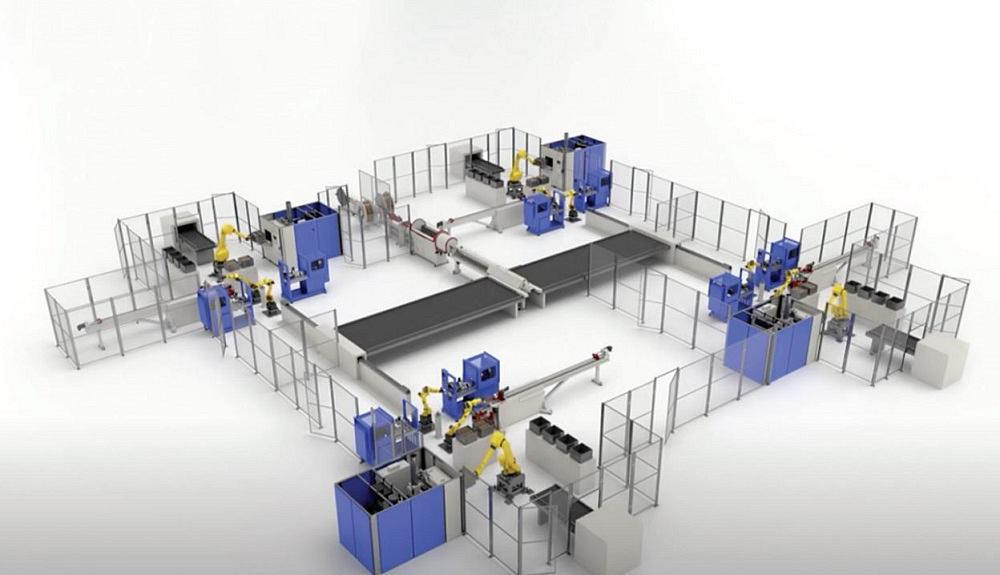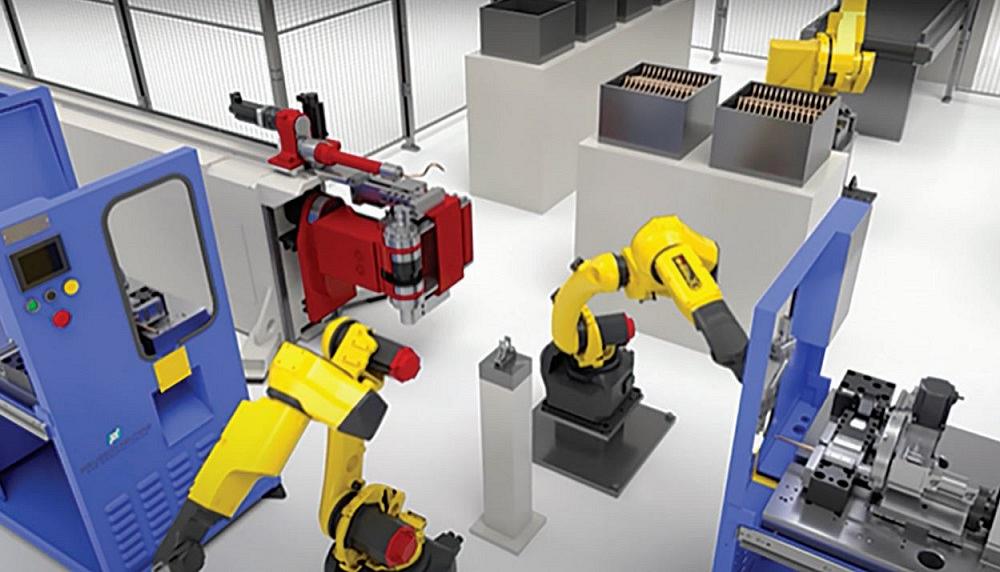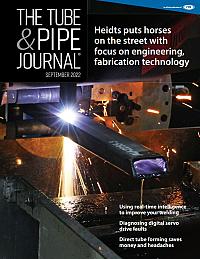Editor
- FMA
- The Fabricator
- FABTECH
- Canadian Metalworking
Categories
- Additive Manufacturing
- Aluminum Welding
- Arc Welding
- Assembly and Joining
- Automation and Robotics
- Bending and Forming
- Consumables
- Cutting and Weld Prep
- Electric Vehicles
- En Español
- Finishing
- Hydroforming
- Laser Cutting
- Laser Welding
- Machining
- Manufacturing Software
- Materials Handling
- Metals/Materials
- Oxyfuel Cutting
- Plasma Cutting
- Power Tools
- Punching and Other Holemaking
- Roll Forming
- Safety
- Sawing
- Shearing
- Shop Management
- Testing and Measuring
- Tube and Pipe Fabrication
- Tube and Pipe Production
- Waterjet Cutting
Industry Directory
Webcasts
Podcasts
FAB 40
Advertise
Subscribe
Account Login
Search
Automated tube forming can take sting out of labor crunch
Robotic cells can help bottom line and existing workers in metal fabrication
- By Lincoln Brunner
- September 13, 2022
- Article
- Automation and Robotics

3D simulation models help companies confirm the specifications of their layout before the cell is actually put together.
Across America, manufacturers and fabrication shops are using many weapons to combat the shortage of highly skilled labor. Some cross-train employees, some beef up internship programs, and still others are investing in some combination of robotic automation and modular design.
The Future of the Shop Floor
A modular design is simply an array of equipment configured into a workcell to complete a specific task.
Say a pipe needs to be cut, bent, and collared before moving to the next phase of production. If every machine requires an operator every shift—and there are numerous machines in a cell—access to labor could become an operational obstacle.
Introducing robotic automation to workcells means that fewer operators are needed on the shop floor. Instead of every machine needing an operator, an automated cell needs just one human operator. In some cases, even multiple work cells, each containing numerous machines, can be run by one operator. With fewer people needed, it’s more feasible for tube and pipe manufacturers to run three full shifts and get more value out of the equipment that they have.
What’s Old Is New Again
The good news is that automated cells do not require the massive investment in new capital that may have priced out many small and medium-sized operations. Old and unused or underused equipment can take on a new life with the help of robotic automation and modular design.
“If you have the machines but no labor to operate them, you can deploy automation and modular design by putting the equipment into a cell and robotically automating it,” said Pat Downing, director of sales, tube fabricating equipment and services, with Wauseon Machine and Mfg. in Wauseon, Ohio. “From there, it’s quite simple to just add other equipment to that cell to make it into a complete solution.”
The Beauty of Modular Design
Modular design, coupled with robotic automation, is an insurance plan for the future because it’s easy to repurpose the system for another job. For example, if a part being made with a modular automated system reaches the end of its product life, then the robots used to automate the machines can be reprogrammed for another job.
Fixed or hard automation—where purpose-built machines are designed and installed to achieve one result—may seem like the right solution or the more affordable solution in some cases. But consider the downside: Fixed automation offers almost none of the flexibility or adaptability to repurpose the equipment for another use.
“There are people who will build a single machine to do a whole process,” Downing said. “But with modular design, we take multiple pieces of equipment and lay it out in a cell with robotic automation so that it’s easily reconfigurable for different parts. So any piece of the cell—including the robots—can be used for something else in the future, should the need arise.”
Robotic automation and modular design in the tube and pipe industry offer a level of flexibility that a fixed system can’t match.

Modular tube forming technology can be a game-changer for manufacturing firms dealing with labor shortage issues.
Benefiting Your People
Automating some manual processes on the shop floor brings a number of benefits and efficiencies to the available labor force.
People are naturally better suited than robots to certain tasks, like loading raw materials into machines or making quality control checks. Automating the right work with robots gives people on the shop floor the time to focus on tasks that cannot be automated or for which a human operator adds greater value.
Automation and modular design also give a shop the opportunity to rethink and reconfigure how it does business.
One modular cell does not have to be dedicated to a single part. Several part families or products can be manufactured across a modular cell, and it’s even possible to run multiple parts in the cell at the same time. To produce a prototype or small-volume batch, operators can disengage the automation and run the cell manually.
“The jobs that used to be automated were high volume, low mix,” Downing said. “Now we’re starting to see more low volume, high mix because of the labor shortage. With the modular design, we can change over pretty quickly to run multiple parts that are low volume, high mix.”
Reconfigurability
As the needs of a business change with time, so do the parts it manufactures.
Reconfigurability is at the heart of modular tube forming technology and robotic automation—the system is built to undergo change. If collaring machines, washers, end formers, or bending machines must be added or removed for the job, the cell can be reconfigured and reprogrammed to meet the need.
“As parts change in the future, we can use the same automation and just change the modular equipment that’s in the cell,” Downing said, noting that the cost of reprogramming the automation is a fraction of what it would be to invest in a whole new workcell.
With a shortage in skilled labor that seems like it’s here to stay and the growing embrace of automation throughout the manufacturing sector, automated, modular tube forming technology can provide value to almost any size business.
About the Author

Lincoln Brunner
2135 Point Blvd.
Elgin, IL 60123
(815)-227-8243
Lincoln Brunner is editor of The Tube & Pipe Journal. This is his second stint at TPJ, where he served as an editor for two years before helping launch thefabricator.com as FMA's first web content manager. After that very rewarding experience, he worked for 17 years as an international journalist and communications director in the nonprofit sector. He is a published author and has written extensively about all facets of the metal fabrication industry.
About the Publication
Related Companies
subscribe now

The Tube and Pipe Journal became the first magazine dedicated to serving the metal tube and pipe industry in 1990. Today, it remains the only North American publication devoted to this industry, and it has become the most trusted source of information for tube and pipe professionals.
start your free subscription- Stay connected from anywhere

Easily access valuable industry resources now with full access to the digital edition of The Fabricator.

Easily access valuable industry resources now with full access to the digital edition of The Welder.

Easily access valuable industry resources now with full access to the digital edition of The Tube and Pipe Journal.
- Podcasting
- Podcast:
- The Fabricator Podcast
- Published:
- 04/16/2024
- Running Time:
- 63:29
In this episode of The Fabricator Podcast, Caleb Chamberlain, co-founder and CEO of OSH Cut, discusses his company’s...
- Trending Articles
Team Industries names director of advanced technology and manufacturing

Orbital tube welding webinar to be held April 23

Push-feeding saw station cuts nonferrous metals

Corrosion-inhibiting coating can be peeled off after use

3D laser tube cutting system available in 3, 4, or 5 kW

- Industry Events
16th Annual Safety Conference
- April 30 - May 1, 2024
- Elgin,
Pipe and Tube Conference
- May 21 - 22, 2024
- Omaha, NE
World-Class Roll Forming Workshop
- June 5 - 6, 2024
- Louisville, KY
Advanced Laser Application Workshop
- June 25 - 27, 2024
- Novi, MI


























